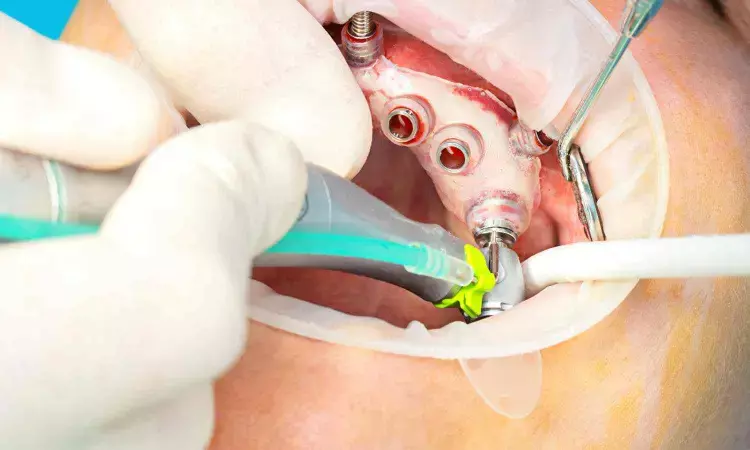- Home
- Medical news & Guidelines
- Anesthesiology
- Cardiology and CTVS
- Critical Care
- Dentistry
- Dermatology
- Diabetes and Endocrinology
- ENT
- Gastroenterology
- Medicine
- Nephrology
- Neurology
- Obstretics-Gynaecology
- Oncology
- Ophthalmology
- Orthopaedics
- Pediatrics-Neonatology
- Psychiatry
- Pulmonology
- Radiology
- Surgery
- Urology
- Laboratory Medicine
- Diet
- Nursing
- Paramedical
- Physiotherapy
- Health news
- Fact Check
- Bone Health Fact Check
- Brain Health Fact Check
- Cancer Related Fact Check
- Child Care Fact Check
- Dental and oral health fact check
- Diabetes and metabolic health fact check
- Diet and Nutrition Fact Check
- Eye and ENT Care Fact Check
- Fitness fact check
- Gut health fact check
- Heart health fact check
- Kidney health fact check
- Medical education fact check
- Men's health fact check
- Respiratory fact check
- Skin and hair care fact check
- Vaccine and Immunization fact check
- Women's health fact check
- AYUSH
- State News
- Andaman and Nicobar Islands
- Andhra Pradesh
- Arunachal Pradesh
- Assam
- Bihar
- Chandigarh
- Chattisgarh
- Dadra and Nagar Haveli
- Daman and Diu
- Delhi
- Goa
- Gujarat
- Haryana
- Himachal Pradesh
- Jammu & Kashmir
- Jharkhand
- Karnataka
- Kerala
- Ladakh
- Lakshadweep
- Madhya Pradesh
- Maharashtra
- Manipur
- Meghalaya
- Mizoram
- Nagaland
- Odisha
- Puducherry
- Punjab
- Rajasthan
- Sikkim
- Tamil Nadu
- Telangana
- Tripura
- Uttar Pradesh
- Uttrakhand
- West Bengal
- Medical Education
- Industry
Nonguided implant placement approach okay for placement of One-piece mini-implants to support mandibular overdenture: Study

Nonguided implant placement approach okay for placement of One-piece mini-implants to support mandibular overdenture suggests a study published in the Clinical Oral Implants Research.
A study was done to assess the relative position of mini-implants to retain a mandibular overdenture, according to the surgical protocol, technical and anatomical factors.Mandibular cone-beam computed tomography (CBCT) scans were analyzed for 73 patients who received four one-piece titanium-zirconium mini-implants. Drilling was performed using a 1.6 mm needle drill and a 2.2 mm Pilot Drill, according to the bone density with a surgical stent.
Post-insertion CBCT images in DICOM format were analyzed using the E-Vol-DX software with BAR filters. Divergence angle between implants and between implants and the overdenture path of insertion was measured using CliniView 10.2.6 software. Results: Divergence between implants ranged from 0° to 22.3° (mean = 4.2; SD = 3.7) in the lateral and from 0° to 26.2° (mean = 5.3; SD = 4.1) in the frontal projections (p < .001). Only 1 (0.2%) and 3 (0.7%) of the measurements were higher than 20° in the lateral and frontal views, respectively.
The mean angulations between the implant and the path of insertion for the overdenture were 9.3° (SD = 7.5) and 4.0° (SD = 2.9) for the lateral and frontal views, respectively (p < .001). Regression analyses showed a significant association between the divergence of implants and the frontal view projection (p < .001), greater distance between the paired implants (p = .017), the flapped surgical protocol (p = .002), higher final insertion torque (p = .011), and deeper preparation with the needle drill (p < .001). The mini-implants were placed with low divergence angles and satisfactory parallelism.
Factors including shorter distances between the implants, higher density bone, and a flapless surgical approach all contributed positively to improved parallelism of the mini-implants.
Reference:
Leles, C. R., de Oliveira Moura-Neto, L., Silva, J. R., Nascimento, L. N., Curado, T. F. F., Costa, N. L., Schimmel, M., & McKenna, G. (2024). A cross-sectional CBCT assessment of the relative position of one-piece titanium-zirconium mini-implants placed for mandibular overdentures using non-guided surgery. Clinical Oral Implants Research, 00, 1–10. https://doi.org/10.1111/clr.14335
Dr. Shravani Dali has completed her BDS from Pravara institute of medical sciences, loni. Following which she extensively worked in the healthcare sector for 2+ years. She has been actively involved in writing blogs in field of health and wellness. Currently she is pursuing her Masters of public health-health administration from Tata institute of social sciences. She can be contacted at editorial@medicaldialogues.in.
Dr Kamal Kant Kohli-MBBS, DTCD- a chest specialist with more than 30 years of practice and a flair for writing clinical articles, Dr Kamal Kant Kohli joined Medical Dialogues as a Chief Editor of Medical News. Besides writing articles, as an editor, he proofreads and verifies all the medical content published on Medical Dialogues including those coming from journals, studies,medical conferences,guidelines etc. Email: drkohli@medicaldialogues.in. Contact no. 011-43720751


